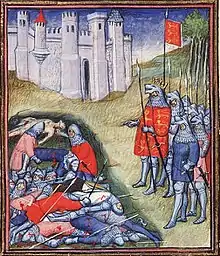Body count
A body count is the total number of people killed in a particular event. In combat, a body count is often based on the number of confirmed kills, but occasionally only an estimate. Often used in reference to military combat, the term can also refer to any situation involving multiple killings, such as the actions of death squads or serial killers.

The military gathers such figures for a variety of reasons, such as determining the need for continuing operations, estimating efficiency of new and old weapons systems, and planning follow-up operations.
Military use
Body count figures have a long history in military planning and propaganda.
Sassanian Empire
According to Procopius, when the Persians are about to march to a war, the king sits on the throne and many baskets are set before him. The men of the army pass along the baskets one by one, each throwing one arrow in the baskets, which are then sealed with the king's seal. When the army returns to Persia, each man takes an arrow, and the number of casualties will be determined by the number of remaining arrows.[1]
The Holocaust
During the Holocaust in Russia, Belarus, Ukraine and other eastern areas, killing was done by Nazi Germany's military police forces, including Einsatzgruppen, the SD, and Wehrmacht police battalions, in massacres by shooting the victims.[2] Such units measured their progress by counting the number of people killed.[3] These murder operations took place under the guise of anti-partisan warfare, but in reality few of those killed were actually partisans.[4]
Vietnam War
Since the goal of the United States in the Vietnam War was not to conquer North Vietnam but rather to ensure the survival of the South Vietnamese government, measuring progress was difficult. All the contested territory was theoretically "held" already. Instead, the U.S. Army used body counts to show that the U.S. was winning the war. The Army's theory was that eventually, the Vietcong and North Vietnamese Army would lose after the attrition warfare.
According to historian Christian Appy, "search and destroy was the principal tactic; and the enemy body count was the primary measure of progress" in General Westmoreland’s war of attrition. Search and destroy was coined as a phrase in 1965 to describe missions aimed at flushing the Viet Cong out of hiding, while the body count was the measuring stick for the success of any operation. This method was controversial, due to two issues. The first is regarding the counting of unarmed civilians killed in actions as enemy combatants in free-fire zone[5] as it was estimated that around 220,000 civilians killed by US/ARVN battle operations were miscounted as "enemy KIA".[6] Another issue is inflation[7][8]and fabrication of body count in after-action reports, which is reported to have given false and inaccurate casualty figures for enemy dead.[9][10]
Iraq War
In the 2003 invasion of Iraq, the US military adopted an official policy of not counting deaths. General Tommy Franks' statement that "we don't do body counts" was widely reported. Critics claimed that Franks was only attempting to evade bad publicity, while supporters pointed to the failure of body counts to give an accurate impression of the state of the war in Vietnam. At the end of October 2005, it became public that the US military had been counting Iraqi fatalities since January 2004 but only those killed by insurgents and not those killed by the US forces.[11]
See also
| Look up body count in Wiktionary, the free dictionary. |
References
- Prokopios, The Wars of Justinian, translated by H. B. Dewing, Hackett Publishing, 2014, ISBN 9781624661723, page
- Beorn 2014, p. 6, 126.
- Beorn 2014, p. 69.
- Beorn 2014, p. 7.
- Lewy, Guenter (1978). America in Vietnam. Oxford University Press. pp. 450–1. ISBN 9780199874231.
- Bellamy, Alex J. (2017-09-29). East Asia's Other Miracle: Explaining the Decline of Mass Atrocities. Oxford University Press. pp. 33–34. ISBN 9780191083785.
- https://articles.latimes.com/1991-01-31/news/mn-442_1_body-count
- Sorley, Lewis (2007). A Better War: The Unexamined Victories and Final Tragedy of America's Last Years in Vietnam. Harvest. pp. 21–2. ISBN 9780156013093.
- Stanton, Shelby L. (2003). The Rise and Fall of an American Army. Random House Publishing Group. pp. xvi–xvii. ISBN 9780891418276.
- "The On-Going Battle for the Soul of the Army | Small Wars Journal". smallwarsjournal.com. Retrieved 2018-05-31.
- "U.S. Quietly Issues Estimate of Iraqi Civilian Casualties", The New York Times
Bibliography
- U.S. Army War College, Study on Military Professionalism, 1970
- Beorn, Waitman Wade (2014). Marching into Darkness. Harvard University Press. ISBN 9780674726604.